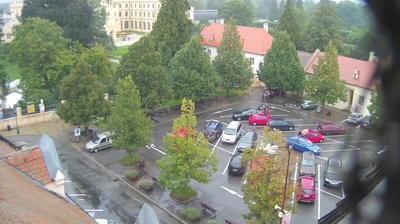Lednicko-valtický areál je zapsán v Seznamu světového kulturního a přírodního dědictví UNESCO. Zámek a ostatní budovy v Lednici jsou otevřeny od dubna do září. V tomto období se dá do Lednice také dostat lodí, která kotví v Břeclavi, nebo u Janohradu. V obci sídlí také Zahradnická fakulta Mendelovy univerzity v Brně, jejíž zaměstnanci a studenti se významně podíleli na rekonstrukcích zámeckého parku a skleníku.
Webkamera - Lednice
Publikováno z / Published by Lookr.com
Zámek 1,Lednice,Jihomoravský Kraj,69144
Návod pro zobrazení StreetView: Žlutého panáčka umistěte na mapu pro zobrazení ulic | Yellow stick figure place on the map = Street View ↑
Lednice (Czech pronunciation: [ˈlɛdɲɪtsɛ]; German: Eisgrub) is a village in South Moravia in the Czech Republic. In 1996 it was inscribed on the UNESCO World Heritage List (together with the twin manor of Valtice) as "an exceptional example of the designed landscape that evolved in the Enlightenment and afterwards under the care of a single family." It contains a palace and the largest park in the country, which covers 200 km².
Since Lednice/Eisgrub first passed into the hands of the House of Liechtenstein in the mid-13th century, its fortunes had been tied inseparably to those of that noble family. The palace of Lednice began its life as a Renaissance villa; in the 17th century it became a summer residence of the ruling Princes of Liechtenstein. The estate house – designed and furbished by baroque architects Johann Bernhard Fischer von Erlach, Domenico Martinelli, and Anton Johan Ospel – proclaimed rural luxury on the grandest scale. In 1846–58 it was extensively rebuilt in a Neo-Gothic style under the supervision of Georg Wingelmüller.
The surrounding park is laid out in an English garden style and contains a range of Romantic follies by Joseph Hardtmuth, including the artificial ruins of a medieval castle on the bank of the Thaya/Dyje River (1801) and a solitary sixty-metre minaret, reputedly the tallest outside the Muslim world at the time of its construction (1797–1804).
Source: WIKIPEDIA



 Lednice (německy Eisgrub) je obec na jižní Moravě, která v polovině 13. století přešla do majetku rodu Lichtenštejnů a patřila jim až do roku 1945. Jedná se o vinařskou obec v Mikulovské vinařské podoblasti (viniční tratě Končiny, Terasy, U Červené studánky, Hlohovsko, Ve starých, Na Valtické, Farské). Lednice se nachází asi 6 km severozápadně od Břeclavi a 12 km východně od Mikulova. Do obce patří i osada Nejdek. Žije zde přibližně 2 300 obyvatel.
Lednice (německy Eisgrub) je obec na jižní Moravě, která v polovině 13. století přešla do majetku rodu Lichtenštejnů a patřila jim až do roku 1945. Jedná se o vinařskou obec v Mikulovské vinařské podoblasti (viniční tratě Končiny, Terasy, U Červené studánky, Hlohovsko, Ve starých, Na Valtické, Farské). Lednice se nachází asi 6 km severozápadně od Břeclavi a 12 km východně od Mikulova. Do obce patří i osada Nejdek. Žije zde přibližně 2 300 obyvatel.
Napiš komentář
K přidání komentáře se přihlaš
Odeslat komentář jako host